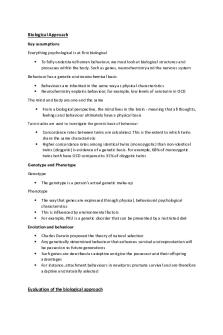Te Whariki Approach PDF

| Title | Te Whariki Approach |
|---|---|
| Course | Child and Youth Studies |
| Institution | University of Derby |
| Pages | 1 |
| File Size | 45.2 KB |
| File Type | |
| Total Downloads | 99 |
| Total Views | 148 |
Summary
Notes and prior reading regarding the Te Whariki approach to learning and teaching for children and young people ...
Description
Te Whariki Approach Te Whariki outlines the ways in which this interconnection and interweaving occur, stating that learning and development will be integrated through;
Tasks, activities and contexts that have meaning for the child, including practices and activities not always associated with the word ‘curriculum’, such as care routines, mealtimes, and child management strategies; Opportunities for open-ended exploration and play; Consistent, warm relationships that connect everything together; Recognition of the spiritual dimension of children’s lives in culturally, socially and individually appropriate ways; recognition of the significance and contribution of previous generations to the child’s concept of self.
-Believe that the family and community is an integral part of the early childhood curriculum. This refers to the responsive and reciprocal relationships with widening communities: the home and other communities to which the family belong. -The curriculum strands are about both teaching and learning. The goals mostly focus on the teaching; the outcomes focus on what the children will be learning. The pedagogy, what the adults, children and places and things do together, interweaves teaching and learning. -Assessments are written as stories of learning in familiar contexts. The learning story is a story written to the child and the family, recognising the complex nature of learning involving affective, social and motivational implications. The assessment practice of learning stories acknowledges assessment as a powerful force for learning. There are three key elements of a learning story: 1) the narrative that describes the significant learning event 2) the analysis of the learning, which can be described as asking the question, ‘What have I learnt about Jack today?’ or ‘what learning do I think was happening?’ 3) the planning. This is not written for every story but may be listed as ‘opportunities and possibilities’. -Learning stories should show how children enhance their sense of themselves as capable people and competent learners. Learning stories are about children’s developing identities as learners, based on the learning dispositions that parallel the five strands of the Te Whariki curriculum...
Similar Free PDFs

Te Whariki Approach
- 1 Pages

Te Metiste
- 5 Pages

Literal Approach
- 3 Pages

Interactionist Approach
- 1 Pages

Literal Approach
- 2 Pages

Biological approach
- 2 Pages

Psychodynamic Approach
- 2 Pages

Te Quiero Mario Benedetti
- 1 Pages

Términos - te lo pregunta
- 5 Pages

Yanmar-4JH4-TE - specifications
- 2 Pages

Te kennen structuurformules
- 3 Pages

Te ansducción de señales
- 59 Pages

Te la creiste Wexd
- 18 Pages
Popular Institutions
- Tinajero National High School - Annex
- Politeknik Caltex Riau
- Yokohama City University
- SGT University
- University of Al-Qadisiyah
- Divine Word College of Vigan
- Techniek College Rotterdam
- Universidade de Santiago
- Universiti Teknologi MARA Cawangan Johor Kampus Pasir Gudang
- Poltekkes Kemenkes Yogyakarta
- Baguio City National High School
- Colegio san marcos
- preparatoria uno
- Centro de Bachillerato Tecnológico Industrial y de Servicios No. 107
- Dalian Maritime University
- Quang Trung Secondary School
- Colegio Tecnológico en Informática
- Corporación Regional de Educación Superior
- Grupo CEDVA
- Dar Al Uloom University
- Centro de Estudios Preuniversitarios de la Universidad Nacional de Ingeniería
- 上智大学
- Aakash International School, Nuna Majara
- San Felipe Neri Catholic School
- Kang Chiao International School - New Taipei City
- Misamis Occidental National High School
- Institución Educativa Escuela Normal Juan Ladrilleros
- Kolehiyo ng Pantukan
- Batanes State College
- Instituto Continental
- Sekolah Menengah Kejuruan Kesehatan Kaltara (Tarakan)
- Colegio de La Inmaculada Concepcion - Cebu


